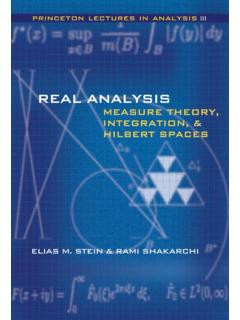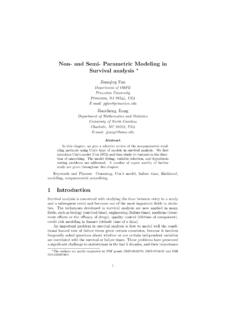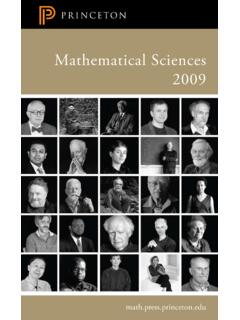Transcription of Ibookroot October 20, 2007 - prof.usb.ve
1 Ibookroot October 20, 2007 FOURIER ANALYSISI bookroot October 20, 2007 PrincetonLecturesinAnalysisI Fourier analysis : An IntroductionII Complex AnalysisIII Real analysis : Measure Theory, Integration, andHilbert SpacesIbookroot October 20, 2007 princeton Lectures in AnalysisIFOURIER ANALYSISan introductionElias M. Stein&Rami ShakarchiPRINCETON UNIVERSITY PRESSPRINCETON AND OXFORDC opyright 2003 by princeton University PressPublished by princeton University Press, 41 William Street, princeton , New Jersey 08540In the United Kingdom: princeton University Press, 6 Oxford Street, Woodstock, Oxfordshire OX20 1 TWAll Rights ReservedLibrary of Congress Control Number 2003103688 ISBN 978-0-691-11384-5 British Library Cataloging-in-Publication Data is availableThe publisher would like to acknowledge the authors of this volume for providing the camera-ready copy from which this book was printedPrinted on acid-free paper.
2 In the United States of America5 7 9 10 8 6 Ibookroot October 20, 2007To my grandchildrenCarolyn, Alison, my parentsMohamed & Mireilleand my October 20, 2007 ForewordBeginning in the spring of 2000, a series of four one-semester courseswere taught at princeton University whose purpose was to present, inan integrated manner, the core areas of analysis . The objective was tomake plain the organic unity that exists between the various parts of thesubject, and to illustrate the wide applicability of ideas of analysis toother fields of mathematics and science. The present series of books isan elaboration of the lectures that were there are a number of excellent texts dealing with individualparts of what we cover, our exposition aims at a different goal: pre-senting the various sub-areas of analysis not as separate disciplines, butrather as highly interconnected.
3 It is our view that seeing these relationsand their resulting synergies will motivate the reader to attain a betterunderstanding of the subject as a whole. With this outcome in mind, wehave concentrated on the main ideas and theorems that have shaped thefield (sometimes sacrificing a more systematic approach), and we havebeen sensitive to the historical order in which the logic of the have organized our exposition into four volumes, each reflectingthe material covered in a semester. Their contents may be broadly sum-marized as series and theory, Lebesgue integration, and Hilbert selection of further topics, including functional analysis , distri-butions, and elements of probability , this listing does not by itself give a complete picture ofthe many interconnections that are presented, nor of the applicationsto other branches that are highlighted.
4 To give a few examples: the ele-ments of (finite) Fourier series studied in Book I, which lead to Dirichletcharacters, and from there to the infinitude of primes in an arithmeticprogression; theX-ray and Radon transforms, which arise in a number ofIbookroot October 20, 2007 FOREWORD problems in Book I, and reappear in Book III to play an important role inunderstanding Besicovitch-like sets in two and three dimensions; Fatou stheorem, which guarantees the existence of boundary values of boundedholomorphic functions in the disc, and whose proof relies on ideas devel-oped in each of the first three books; and the theta function, which firstoccurs in Book I in the solution of the heat equation, and is then usedin Book II to find the number of ways an integer can be represented asthe sum of two or four squares, and in the analytic continuation of thezeta few further words about the books and the courses on which theywere based.
5 These courses where given at a rather intensive pace, with 48lecture-hours a semester. The weekly problem sets played an indispens-able part, and as a result exercises and problems have a similarly im-portant role in our books. Each chapter has a series of Exercises thatare tied directly to the text, and while some are easy, others may requiremore effort. However, the substantial number of hints that are givenshould enable the reader to attack most exercises. There are also moreinvolved and challenging Problems ; the ones that are most difficult, orgo beyond the scope of the text, are marked with an the substantial connections that exist between the differentvolumes, enough overlapping material has been provided so that each ofthe first three books requires only minimal prerequisites: acquaintancewith elementary topics in analysis such as limits, series, differentiablefunctions, and Riemann integration, together with some exposure to lin-ear algebra.
6 This makes these books accessible to students interestedin such diverse disciplines as mathematics, physics, engineering, andfinance, at both the undergraduate and graduate is with great pleasure that we express our appreciation to all whohave aided in this enterprise. We are particularly grateful to the stu-dents who participated in the four courses. Their continuing interest,enthusiasm, and dedication provided the encouragement that made thisproject possible. We also wish to thank Adrian Banner and Jose LuisRodrigo for their special help in running the courses, and their efforts tosee that the students got the most from each class. In addition, AdrianBanner also made valuable suggestions that are incorporated in the October 20, 2007ixFOREWORDWe wish also to record a note of special thanks for the following in-dividuals: Charles Fefferman, who taught the first week (successfullylaunching the whole project!)
7 ; Paul Hagelstein, who in addition to read-ing part of the manuscript taught several weeks of one of the courses, andhas since taken over the teaching of the second round of the series; andDaniel Levine, who gave valuable help in proof-reading. Last but notleast, our thanks go to Gerree Pecht, for her consummate skill in type-setting and for the time and energy she spent in the preparation of allaspects of the lectures, such as transparencies, notes, and the are also happy to acknowledge our indebtedness for the supportwe received from the 250th Anniversary Fund of princeton University,and the National Science Foundation s VIGRE M. SteinRami ShakarchiPrinceton, New JerseyAugust 2002 Ibookroot October 20, 2007 Preface to Book IAny effort to present an overall view of analysis must at its start dealwith the following questions: Where does one begin?
8 What are the initialsubjects to be treated, and in what order are the relevant concepts andbasic techniques to be developed?Our answers to these questions are guided by our view of the centralityof Fourier analysis , both in the role it has played in the development ofthe subject, and in the fact that its ideas permeate much of the present-day analysis . For these reasons we have devoted this first volume to anexposition of some basic facts about Fourier series, taken together witha study of elements of Fourier transforms and finite Fourier this way allows one to see rather easily certain applications toother sciences, together with the link to such topics as partial differentialequations and number theory. In later volumes several of these connec-tions will be taken up from a more systematic point of view, and the tiesthat exist with complex analysis , real analysis , Hilbert space theory, andother areas will be explored the same spirit, we have been mindful not to overburden the begin-ning student with some of the difficulties that are inherent in the subject:a proper appreciation of the subtleties and technical complications thatarise can come only after one has mastered some of the initial ideas in-volved.
9 This point of view has led us to the following choice of materialin the present volume: Fourier series. At this early stage it is not appropriate to intro-duce measure theory and Lebesgue integration. For this reasonour treatment of Fourier series in the first four chapters is carriedout in the context of Riemann integrable functions. Even with thisrestriction, a substantial part of the theory can be developed, de-tailing convergence and summability; also, a variety of connectionswith other problems in mathematics can be illustrated. Fourier transform. For the same reasons, instead of undertakingthe theory in a general setting, we confine ourselves in Chapters 5and 6 largely to the framework of test functions. Despite these lim-itations, we can learn a number of basic and interesting facts aboutFourier analysis inRdand its relation to other areas, including thewave equation and the Radon October 20, 2007 PREFACE TO BOOK I Finite Fourier analysis .
10 This is an introductory subjectpar excel-lence, because limits and integrals are not explicitly present. Nev-ertheless, the subject has several striking applications, includingthe proof of the infinitude of primes in arithmetic into account the introductory nature of this first volume, wehave kept the prerequisites to a minimum. Although we suppose someacquaintance with the notion of the Riemann integral, we provide anappendix that contains most of the results about integration needed inthe hope that this approach will facilitate the goal that we have setfor ourselves: to inspire the interested reader to learn more about thisfascinating subject, and to discover how Fourier analysis affects decisivelyother parts of mathematics and October 20, 2007 ContentsForewordPrefaceChapter 1.












